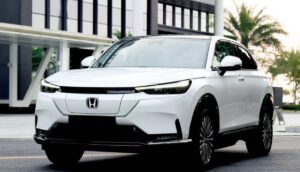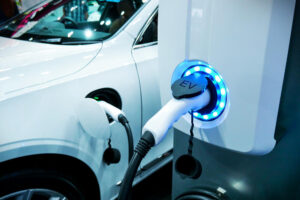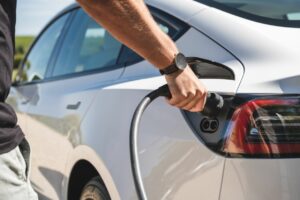
Ukrainians purchased 31,750 electric vehicles in January-June this year, which is 30% more than in the same period in 2024, according to UkrAvtoprom on Telegram.
The share of new vehicles in BEV registrations was 18%, compared to 20% in the same period last year.
In particular, sales of electric passenger cars increased by 28% to 30,760 units, commercial vehicles by 2.1 times to 987 units, and three electric buses were sold (one last year).
The top five new electric vehicles on the market in the first half of the year were BYD Song Plus with 967 units, Volkswagen ID.Unyx with 830 units, Honda eNS1 with 441 units, Zeekr 7X with 402 units, and Zeekr 001 with 366 units.
The top five used electric vehicles registered for the first time included Tesla Model Y (2,968 units), Nissan Leaf (2,853 units), Tesla Model 3 (2,670 units), KIA Niro EV – 1,664 units, and Hyundai Kona – 1,496 units.
As reported, last year, according to UkrAvtoprom, registrations of electric vehicles (new and used) increased by 38% compared to 2023, to 51,700 units, including passenger cars – by 37%, to 50,458 units, commercial vehicles – by 64%, to 1,264 units, and two electric buses were also registered. The share of new electric vehicles in these figures was 20%.
In turn, The Automotive Market Research Institute notes on its website that in June of this year, the total volume of the electric vehicle segment (imported used, new, domestic market) amounted to almost 9,000, which is 2.3% less than in May of this year, but 43.4% more than last June.
“Despite the overall slowdown in the Ukrainian car market, the electric vehicle segment has every chance of maintaining its positive momentum. According to the Institute’s analysts, growth will continue this year, primarily due to the fact that VAT on customs clearance of electric cars will return to Ukraine in 2026,” the report says.
Analysts believe that this will inevitably lead to an increase in their cost by at least 20-30%, while the choice will narrow. Fuel prices, which have risen sharply by several hryvnia per liter, also play a role, giving electric transport an advantage.
According to the institute’s experts, in June, the share of used imported electric vehicles in the sub-segment was 53.3% (4,792 units), new vehicles – 16.2% (1,458 units), and domestic resales – 30.4% (2,735 units).
“As of the end of June 2025, in Ukraine (excluding industrial electric cars, trolleybuses, and rail vehicles), the BEV transport fleet consists of 171,100 units. The largest share is held by passenger cars (166,400), followed by trucks (3,600), electric buses (8), and various motor vehicles (over 1,000),” the report says.

The Chinese company Jiangling Group Electric Vehicle (JMEV) plans to build an electric vehicle manufacturing plant in Sremska Mitrovica in northwestern Serbia with the long-term goal of exporting cars to the European Union without paying duties. This was reported to Radio Free Europe by Brancica Zjalic, JMEV project manager in Serbia.
“The size of the investment will be determined in the next two months and depends on whether we will produce three thousand or five thousand cars a year,” Zjalic said. She added that Serbia was chosen because of its good economic relations with both China and the EU. “Serbia is a kind of bridge between China and Europe in terms of sales of electric vehicles,” she said.
In October 2024, the European Union imposed high duties (up to 35%) on electric vehicles made in China for five years to protect European automakers from allegedly unfair competition from Chinese manufacturers that benefit from government subsidies.
Serbia, for its part, signed a free trade agreement with China that entered into force in 2024, which has drawn criticism from the EU given Serbia’s status as a candidate for accession to the Union.
Source: https://t.me/relocationrs/542

In 2024, registrations of electric vehicles (new and used) in Ukraine increased by 38% compared to 2023 – up to 51.7 thousand units, Ukravtoprom reported on its telegram channel.
In particular, registrations of passenger cars increased by 37% to 50,458 thousand, commercial vehicles by 64% to 1,264 thousand, and two electric buses were registered.
The share of new vehicles in zero-emission vehicle (BEV) registrations was 20%, the same as in 2023.
The top five new electric cars of the year were headed by Volkswagen ID.4 (1626 units), followed by Honda M-NV (1279 units), BYD Song Plus (1007 units), Nissan Ariya (766 units) and Zeekr 001 (703 units).
The most popular five used cars are Nissan Leaf – 5511 units; Tesla Model 3 – 4639 units; Tesla Model Y – 4225 units; VW e-Golf – 2479 units and Hyundai Kona Electric – 2337 units.
“Ukravtoprom informs that in December last year, Ukrainians purchased almost 3.8 thousand electric vehicles, 18% less than a year earlier, including more than 3.6 thousand passenger cars (-20%) and 124 commercial vehicles (+59%).
As reported, in 2023, according to Ukravtoprom, registrations of new and used electric cars in Ukraine increased 2.8 times to 37.6 thousand, with new cars accounting for 20% compared to 17% a year earlier.
In turn, the Auto-Consulting information and analytical group, analyzing the market of new passenger electric cars, noted that their share in December amounted to only 11.5% of sales in the market of new passenger cars.
“This is the lowest figure for the whole of 2024,” the group said on its website.
The group’s analysts remind that 2024 began with a 23.7% share of electric cars, but it declined further.
“The catalyst for this process was the shelling of Ukraine’s energy infrastructure. And after each prolonged power outage, a decrease in the share of electric vehicles among new cars purchased was recorded,” the report says.
According to Auto-Consulting, at the end of the year, electric cars accounted for 16.1% of the new car market, which is 1 percentage point less than in 2023, but after the powerful shelling of the energy sector in November and December, the lowest figure was recorded – 11.5%.
“This is despite numerous tax incentives for the import of electric cars. It is clear that this trend is temporary and is caused by the enemy’s attacks on Ukraine’s energy sector, which is a cause for concern among consumers. However, the enemy has actually slowed down the trend of rapid transition to electric mobility in the Ukrainian car market,” analysts say.
At the same time, among other reasons for the decline in demand for electric vehicles, they name a decrease in the supply of popular models of VW ID.4, Honda and others. In addition, unofficial electric vehicles are increasingly facing price changes and service issues.

Japanese automaker Honda Motor Co. is considering the possibility of building an electric vehicle manufacturing plant in Canada, the Nikkei newspaper reports.
Investments in the project could reach 2 trillion yen ($14 billion).
Honda is considering several sites for the construction of the plant, including a site near the company’s existing facility in Ontario. The project may include the creation of facilities for the production of electric vehicle batteries, Nikkei notes.
The automaker intends to make a decision on the site for the construction of the Canadian plant by the end of 2024. The plant is expected to start operating in early 2028.
Honda is preparing to start production of electric vehicles and batteries in the US state of Ohio in 2026, and the Canadian plant will become the second largest Japanese company in North America.
This region accounts for about 40% of all Honda sales.

Initial registrations of electric vehicles in Ukraine in January-September 2023 increased 2.7 times compared to the same period in 2022, amounting to approximately 24.2 thousand units, while the share of new cars increased to 20% from 15%, Ukravtoprom reported on its Telegram channel on Tuesday.
At the same time, in September, according to the association, registrations increased by 12% compared to August this year and 2.7 times compared to September last year – up to 4,298 thousand units, including 775 new and 3,523 used cars.
The lion’s share of registrations, as before, is occupied by passenger cars – 4.215 thousand units (new – 769 units, used – 3,446 units), and only six of 83 commercial electric vehicles were new.
The TOP-5 new electric vehicles on the market in July included Volkswagen ID.4 – 350 units; Volkswagen ID.6 – 66 units; Toyota BZ4X – 51 units, Honda E – 49 units, BYD Yuan Plus – 19 units.
The top five used cars, as in August, were Nissan Leaf – 590 units; Volkswagen e-Golf – 433 units; Tesla Model 3 – 405 units; Tesla Model Y – 247 units and Renault Zoe – 194 units.
As reported, according to Ukravtoprom, Ukrainians purchased 13.6 thousand electric vehicles (new and used) in 2022, 1.5 times more than a year earlier, while the share of new vehicles increased to 17% from 14%.